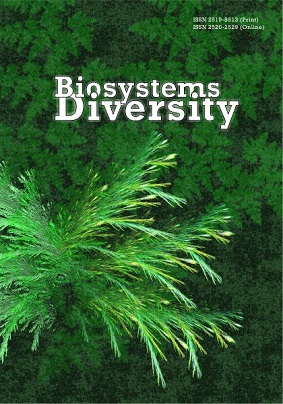Оцінка і прогноз інвазійності деяких адвентивних рослин за впливу кліматичних змін у Степовому Придніпров'ї
Assessment and prediction of the invasiveness of some alien plants in conditions of climate change in the steppe Dnieper region
Author(s): L. V. Shupranova, A. A. Alexeyeva, O. O. Didur, S. S. Kravets, V. L. Matyukha, I. A. Ivan’ko, N. A. Khromykh, Y. V. LykholatSubject(s): Sociobiology
Published by: Дніпропетровський національний університет імені Олеся Гончара
Keywords: warming; alien plants; seed reproduction; the initiation of invasiveness;
Summary/Abstract: The flora of the steppe Dnieper region is characterized by an abundance of naturalized alien species, some of which colonised over the last decade. Climate change, associated primarily with increasing temperature, became clearly manifested in this period. We tested the hypothesis that there is an association between climate change and the initiation of invasiveness of some alien plant species in the steppe Dnieper region. For this purpose, comparative studies of the distribution boundaries of naturalized alien trees, shrubs and herbaceous plants were conducted. Along the research route numerous 5–10-year-old broadleaf linden trees (Tilia platyphyllos Scop.) were found in the man-made plantation communities of Dnipro city in areas with moist soil; seeded undergrowth was located at a significant distance from the adult linden plants. Numerous groups of young 7–10-year-old plants of the smoke trees (Cotinus coggygria Scop.), which had a seed origin, were found in the shelterbelt and urban recreational plantations. Young 10–12-year-old virginal and generative plants of the black cherry (Padus serotina Ehrh.) were found in large numbers in both the seminatural and artificial plant communities at great distances from the adult trees. The alien plant species common hackberry (Celtis occidentalis L.) showed the ability to form fairly sparse seminal seedlings, which was presented by the plants at the age of 4–7 years in both the natural and urban plant communities. The perennial herbaceous plant common milkweed (Asclepias syriaca L.) was found in the course of the research in ruderal habitats, urban plant communities, and also in the agrocoenoses. The common milkweed reached its greatest abundance in fields of winter crops, where the spread of this species was accompanied by a sharp decrease in the number of other species of segetal plants. Our study results confirm that the extension of the distribution boundaries of alien species over the last decade was not related to the ground conditions of the steppe Dnieper region. At the same time, changes in climatic conditions were favourable for some naturalized alien species because they have created the opportunity for seed reproduction of species away from the maternal plants. Alien species C. coggigria, P. serotina and A. syriaca were also the most sensitive to the influence of the climate changes. Consequently, these species have the greatest potential for increasing their level of invasiveness and endangering the biodiversity in the steppe Dnieper region under conditions of climate change. We suggest that a simultaneous initiation of invasiveness of these several alien species leads to an increase in the degree of threat to the diversity of natural plants in the region. The study results confirm the urgent need for analysis and forecasting of the consequences of introduction of alien species, in order to prevent the undesirable effects that this would bring for the region’s native vegetation.
Journal: Biosystems Diversity
- Issue Year: 25/2017
- Issue No: 1
- Page Range: 52-59
- Page Count: 8
- Language: Ukrainian

